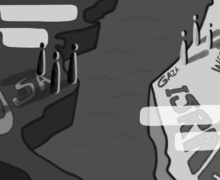Abroad : Chinese tourism boom provides rural population with new pastime: tourist watching
At the foot of the Songshan Mountains in central China, tucked in a river valley, lies the Shaolin Temple. It’s been a center for Buddhist worship since the fifth century, a renowned training center for Chinese martial arts and perhaps the largest cash cow for Henan Province, a relatively poor, inland region of China.
What could be more stereotypically Chinese than kung fu, you ask? The answer reveals a lot about the modern commercial revolution in China, and perhaps the influence of Jet Li performing roundhouse kicks in old Hong Kong movies.
Tourism is booming in China. In 2010, the country earned the equivalent of $220 billion in tourism revenue. In the first quarter of 2011 alone, China made the equivalent of more than $90 billion, up by 19 percent from the same period last year, according to the China Tourism Academy.
The Shaolin Temple is indicative of that trend. Its recent renovation and the establishment of a tourist-friendly park on the former kung fu training grounds provide a window into those statistics.
By American standards, the temple training is a little off the beaten path. Dengfeng, the nearest city, is a long bus ride away. Wheat farmers traipsing down dusty streets or shopkeepers selling wheat noodles don’t see many foreigners because Dengfeng sits a few hours through wind-whipped mountains from the provincial capital of Zhengzhou, itself an overnight train ride away from Beijing.
Naturally, when they do see a group of American students, Dengfeng farmers or shopkeepers like to stare. It’s the kind of stare that expresses curiosity, not contempt — the subtle raise of an eyebrow or a prolonged interested look. Some stare to see every pore, every piece of strange clothing or strange hair or strange eyes. It’s the kind of look that gives you an ‘I have a feeling we’re not in upstate New York anymore.’ As we enter the countryside, it’s as if the circus has come to town.
But Dengfeng is one of China’s hopes in attracting enough tourists to overtake France, Spain and the United States and become the world’s most visited country for tourism. At its current pace, China is poised to surpass all three by 2015, according the United Nations World Tourism Organization.
The temple and its surrounding park have been lauded by the United Nations Educational, Scientific and Cultural Organization as some of the historic monuments of Dengfeng, bringing with it not only prestige, but money for preservation and restoration.
I imagined seeing real kung fu, white-knuckle acrobatics without any movie editing. I imagined monks in yellow robes learning self-discipline and self-defense. I imagined taking a look at a simple but satisfying life, free of materialism or desire.
Instead, sneaky schoolgirls would whip out their cellphones for a picture of the foreigners. Excited locals yelled out requests for pictures or brazenly grabbed an arm. At times, I slipped my sunglasses on and put up a Lindsay Lohan-esque hand in front of my face to keep them at bay. Some would sulk a little until we said yes, and then they would invite more of their friends over. These inevitably ended up with more than one impromptu photo shoot. It was surreal, to say the least.
The barrage of amateur paparazzi emerged at a forest of small Pagodas where monks sell beads and bracelets. Then we waded past stalls of vendors selling more beads and figurines. Some wily merchants sold noodles for three times the price of those Dengfeng shopkeepers. We pushed through the crowd of photographers, beating a path to postcard shops, gourmet biscuit emporiums, tea stalls, even a strange camel ride that charged people by the minute.
If this was Disneyland, then I was in a Goofy suit. The sun beat down a little. The tea and noodles looked good. And after our umpteenth group photo with strangers, we debated charging five yuan per picture to pay for some of the souvenirs or lunch.
When we finally bought tickets to see the temple, the two men behind a rough wooden desk sized us up. It was easy to spot the foreigners, I assume. They immediately said the ticket price was three times what we were told. Crowds swarmed the entry gate to take pictures in front of the famous temple. We stalked off to buy some overpriced noodles instead of going inside.
Even off the beaten path, under those Songshan Mountains in central China, tucked in a river valley, tourism has certainly reached Dengfeng — but for now, I’m unsure whether it is the foreigners or the locals who are the tourists.
Andrew Swab is a junior magazine journalism and international relations major. His column appears occasionally. He can be reached at ajswab@syr.edu.
Published on April 13, 2011 at 12:00 pm





